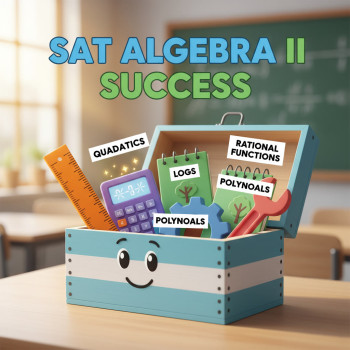Why the SAT went digital (and why that actually helps you)
Change feels risky, especially when the stakes are high. The SAT moving to a digital format has stirred a lot of emotions—excitement, confusion, and, for some, mild panic. But underneath the headlines is a simple idea: testing should reflect how students read, write, and solve problems today. Digital delivery makes the test shorter, more secure, and in theory, better aligned with the kinds of tasks you do in real life.
Think of it this way: your phone and laptop are where you read, research, and calculate. The digital SAT meets you there. It’s not trying to trick you with gimmicks; it’s trying to measure critical thinking and problem solving in a faster, more flexible way. The trick for you is to learn how to perform under the new format.
Get comfortable with the structure (without memorizing the wrong things)
One of the most important early steps is understanding how the test is organized. Unlike the old paper test, the digital SAT is delivered on a secure device and typically divided into modules. Each subject—reading & writing and math—is split into two parts. Your performance in the first module can influence the difficulty of the second module: that’s called adaptive testing. But the core content—vocabulary in context, evidence-based reading, grammar in context, and math problem solving—remains the same.
Rather than obsessing over a single minute-by-minute schedule, focus on these reliable signals:
- Questions can range in difficulty. An early cluster of easier questions doesn’t mean the rest will be easy, and a tough question early does not doom you.
- Adaptive formats reward consistent accuracy. A calm, steady pace and careful checking will typically beat frantic guessing followed by panic.
- Tools you once used on paper—ruling out answers, annotating passages, sketching geometry—are still useful. You’ll just need to adapt those strategies to digital tools (highlighters, the built-in calculator, flagging questions).
Quick comparison: paper vs. digital (what actually changed)
| Feature | Paper SAT | Digital SAT |
|---|---|---|
| Delivery | Printed booklets | Secure testing app on a device |
| Sections | Separate Reading, Writing & Language, Math | Reading & Writing combined, Math—each split into modules |
| Time | Longer total seat time | Shorter overall testing time |
| Adaptivity | Static set of questions | Section-level adaptivity (module-to-module) |
| Tools | Scratch paper, physical calculator (when allowed) | On-screen tools, built-in calculator, and approved scratch paper |
Before you test: setup, devices, and practice that actually matters
One of the biggest stressors for students is logistics. Is my device compatible? Do I have the right charger? What if the Wi-Fi goes down? The good news is that test administrators plan for most of these problems. Still, there are a few practical habits that separate calm students from frazzled ones:
- Practice on the same kind of device you’ll use on test day. If the test uses a provided laptop, try the practice app or a similar tablet experience to get used to the on-screen navigation.
- Set up a comfortable workspace. The digital test asks for focus; practice sessions should mimic that environment—no phone on the desk, comfortable lighting, and a quiet room.
- Get used to on-screen tools. Learn the highlighter, the flagging system, and the on-screen calculator if available. Muscle memory is real: the faster your fingers find the tool, the fewer seconds you waste during the test.
- Bring multiple charged batteries and any allowed accessories. Pack snacks and water for after the test—stamina matters.

Pacing and time management for a shorter, faster test
Because the digital SAT tends to be shorter, pacing feels different. You’ll have less total seat time, so each question carries a slightly higher weight in terms of seconds per question. But that also means there’s less endurance strain: if you maintain a steady pace, you’ll likely feel sharper near the end rather than drained.
Here are practical pacing habits that actually work:
- Learn target timing for question types, not the clock. For example, learn how long a typical evidence-based reading question takes you on average, and practice hitting that range consistently.
- Use the flagging feature. If you hit a question that will cost you more than the allotted seconds, flag and move on. Return to flagged items if time allows.
- Do a quick triage. If you can eliminate two answer choices in under 30 seconds, make an educated selection rather than overthinking for three minutes.
- Plan a micro-check at the end of each module. Spend the last 3–5 minutes revisiting flagged items rather than answering fresh questions.
Example: A realistic micro-pacing plan
Imagine a 30-question module that you should complete in 20 minutes. That’s 40 seconds per question on average. Build a plan like this:
- First pass: 30 seconds per question—answer or flag
- Second pass: Return to flagged questions—give 60–90 seconds for tougher problems
- Final sweep: Use remaining minutes to check calculations, read the question stem again, and confirm answers
This kind of structured rhythm keeps you from getting stuck and helps the adaptive system work in your favor: steady accuracy beats intermittent brilliance.
Section-by-section tactics: Reading & Writing
Digital passages are often shorter and designed to fit the screen better. That means you might see more passages and fewer multi-page essays. The test values evidence and synthesis: it’s less about archaic vocabulary and more about how quickly you can extract relevant details.
Strategies that transfer from paper still work, with small adjustments:
- Annotate the digital passage. Highlight the claim, evidence, and any numerical data. A quick underline of the thesis sentence can save time when answering multiple questions about the same paragraph.
- Question-first approach: Read the question before diving deep into the passage when the question is detail-oriented. For broader questions, skim the passage for structure first.
- Watch for evidence-based questions: they often ask not only what the author says but why or how a particular detail supports a claim.
- For grammar and usage, rely on clarity and concision. Many correct choices will sound natural; the SAT favors the option that eliminates redundancy and awkward construction.
Section-by-section tactics: Math
On-screen math comes with a built-in calculator for the portions where calculators are allowed. You’ll still need strong number sense because some questions are designed to be solved more quickly with clever reasoning than with long computations.
Practical math habits include:
- Work neatly on scratch paper. Even though your answers go in a digital box, you’ll think better with pencil and paper in front of you—draw diagrams, mark knowns and unknowns, and write short plans.
- Use estimation strategically. When exact computation would take a long time, estimate to eliminate improbable answer choices quickly.
- Memorize a handful of formulas and techniques: slope-intercept, basic geometry area/volume, and standard algebra manipulations. These will save time every test day.
- Practice with the on-screen calculator so you know which functions are fastest for you (and when it’s better not to use it at all).
Example math problem approach
Given a geometry diagram with a right triangle and one side labeled, instead of diving into trig if you see a Pythagorean opportunity, do that first. Estimating or sketching proportions can often point to the right answer faster than algebraic churn.
Adaptive testing: how to think about difficulty and your mindset
Adaptive testing can sound intimidating, but it’s helpful to reframe it: the test is trying to match questions to your current level so it can measure you more precisely. That means your best move is to stay calm and accurate in early questions. A string of careless errors early on will push you into a lower-difficulty module; accurate steady work can unlock slightly tougher questions that allow you to earn more points.
Actions that support the right mindset:
- Treat early questions as priceless. Spend the time needed to be confident—they set the tone.
- Don’t panic after a hard question. A single tough item won’t determine your whole score.
- Practice modules in timed sets at home to get emotionally familiar with the experience of advancing (or adjusting) between modules.
Practice smart, not just more
Quantity matters, but quality matters more. Effective practice is targeted and reflective. Instead of doing endless untimed problem sets, adopt a practice loop: analyze, practice, reflect, and adjust.
- Start with a diagnostic: identify your weak patterns, not just weak topics. For instance, you might be perfectly capable with quadratic equations but consistently make careless graph-reading mistakes.
- Create micro-goals. Rather than “get better at reading,” target “improve passage-summarizing accuracy from 70% to 85% in three weeks.”
- Use mixed practice modules. The digital format rewards being able to switch quickly between question types.
- Time-bound practice. Train with the exact time constraints and tools (highlighter, calculator) you’ll have on test day.
How personalized tutoring speeds this up (a quick note on Sparkl’s approach)
When progress stalls, a skilled tutor can shorten the learning curve. Sparkl’s personalized tutoring—1-on-1 guidance, tailored study plans, expert tutors, and AI-driven insights—helps pinpoint the patterns behind mistakes and builds routines that align with the digital format. Tutors can simulate module-style practice, offer immediate feedback, and help you develop pacing instincts that are hard to build on your own.
Stress, sleep, and the surprisingly large role of routine
People often underestimate the cognitive cost of poor sleep and stress. The digital SAT’s shorter format makes these factors even more relevant: with less margin for recovery mid-test, the mental clarity you bring to day one matters a lot.
Practical routine tips:
- Simulate test-day sleep. Don’t schedule an all-nighter before a practice test and then plan to sleep normally on real test day; keep your sleep schedule consistent leading into the exam.
- Do two full, timed practice tests in the weeks before the real one. Treat them like real test days—wake up at the same time, eat the same breakfast, and use your exact testing setup.
- Build a pre-test checklist: device charged, permitted scratch paper, acceptable calculator (if relevant), and a small mental routine (breathing, short warm-up questions) that calms you before you begin.

What to do the week before, the day before, and the morning of
The final week is about consolidation, not cramming. You want to reinforce patterns and confidence.
- One week before: do focused review sessions on your weakest areas. Work smart—short, deliberate practices with immediate reflection.
- Three days before: take a lighter full-length practice test to keep timing fresh without burning out.
- The day before: no heavy new learning. Relax, review a concise cheat-sheet of formulas and strategies, and sleep well.
- The morning of: eat a balanced breakfast, do a five- to ten-minute brain warm-up (a few easy practice questions), and arrive early to the test center or launch your test app calmly.
After the test: interpreting your results and planning your next steps
When scores come back, the smartest response is a calm one. If you did better than expected, celebrate and reflect on what worked. If you fell short, resist the urge to panic. Analyze the score report with curiosity: which question types dropped your points? Which modules showed strength? Use that data to guide a focused study cycle rather than a scattershot effort.
If you need more structure, targeted 1-on-1 support can accelerate improvement. Tutors who understand the digital format can help you convert insights into habits—how to triage questions, how to annotate passages quickly, and how to keep calm while a module shifts in difficulty.
Final pep talk: your test, your routine
The move to a digital SAT is more of an evolution than a revolution. The core skills—clear thinking, precise reading, and smart problem solving—are unchanged. What has changed is the format and the tools. The best way to master that change is to practice deliberately with the right environment and habits.
Keep these last three ideas in mind:
- Build muscle memory for the interface and tools so they become invisible on test day.
- Prioritize steady accuracy over flashy problem-solving; adaptivity rewards reliability.
- Use targeted practice and, when needed, a thoughtful tutor relationship (like Sparkl’s tailored and AI-informed approach) to close the gap quickly.
Take a breath. This transition favors students who prepare thoughtfully, not frantically. With a few smart habits, steady practice, and attention to the way the digital test rewards consistent accuracy, you can walk into test day calm, ready, and capable.
Good luck—you’ve got this. One steady step at a time is all it takes to turn the digital SAT from a source of stress into a stage where you get to show what you know.















No Comments
Leave a comment Cancel